Affordable Dozer Rental Providers Near You
Affordable Dozer Rental Providers Near You
Blog Article
Leasing Vs. Acquiring Building And Construction Equipment: Making the Right Selection for Your Task
When getting started on a construction project, one of the important decisions that forecast stakeholders and supervisors deal with is whether to acquire or rent building and construction tools. The choice pivots on different variables such as cost factors to consider, task period, devices upkeep, versatility, threat, and scalability monitoring.
Cost Factors To Consider
Renting tools frequently requires lower preliminary repayments contrasted to acquiring, making it an eye-catching choice for short-term tasks or contractors with spending plan restraints. In the long run, constantly renting out devices can build up higher expenses than purchasing, particularly for prolonged tasks.
On the various other hand, acquiring building and construction tools involves greater ahead of time prices but can result in long-term savings, especially for lasting projects or frequent users. Inevitably, the choice between leasing and buying building tools hinges on the task's duration, frequency of usage, budget plan considerations, and long-lasting monetary goals.
Job Duration

On the other hand, for long-term tasks or recurring building and construction job, getting equipment might be the extra affordable alternative. Getting equipment can cause cost financial savings over time, especially if the equipment will be frequently made use of. In addition, owning equipment supplies a sense of control over its availability and permits for personalization to fit particular job requirements.

Tools Upkeep
Offered the crucial function job duration plays in establishing the most cost-efficient technique in between renting and buying construction tools, the focus now shifts in the direction of examining the important element of equipment upkeep. On the various other hand, owning devices calls for a proactive approach to maintenance to stop breakdowns, make sure safety, and prolong the equipment's life-span. Inevitably, a well-maintained building devices fleet, whether rented out or possessed, is vital for the effective and successful conclusion of building tasks.
Flexibility and Scalability
In the world of construction devices monitoring, the aspect of versatility and scalability holds substantial importance for task efficiency and resource utilization. Opting to rent building equipment offers a high level of adaptability as it permits the fast adjustment of devices kinds and amounts based on the advancing requirements of a job. Renting makes it possible for professionals to access a large range of specialized tools that may be required for specific tasks without the lasting commitment construction equipment rentals of ownership. This flexibility is especially beneficial for jobs with varying requirements or unclear periods (mini excavator rental).
Moreover, scalability, another essential element, is naturally linked to flexibility. Leasing building equipment supplies the advantage of easily scaling operations up or down as project needs vary. Specialists can swiftly trade or add tools to match the job's changing requirements without the restraints of having possessions that might end up being underutilized or outdated. This capacity to scale resources successfully can cause price financial savings and enhanced project timelines, making renting out a beneficial alternative for jobs requiring versatility and responsive resource appropriation.
Danger Monitoring
Efficient risk management in construction tools operations is critical to guaranteeing project success and mitigating potential financial losses. Building projects naturally entail numerous dangers, such as equipment failures, crashes, and task hold-ups, which can dramatically influence the task timeline and spending plan. By carefully taking into consideration the dangers connected with owning or leasing building equipment, job supervisors can make educated decisions to reduce these prospective threats.
Leasing building equipment can supply a degree of threat mitigation by moving the responsibility of repair and maintenance to the rental firm. This can reduce the financial worry on the project owner in instance of unanticipated equipment failures (heavy equipment rental). Additionally, renting provides the flexibility to access specific devices for particular task stages, reducing the threat of possessing underutilized machinery
On the other hand, having construction tools offers a feeling of control over its use and maintenance. However, this also implies bearing the complete obligation for fixings, maintenance prices, and depreciation, boosting the financial threats related to tools ownership. Careful threat evaluation and consideration of aspects such as project period, equipment utilization, and upkeep requirements are important in establishing one of the most ideal option for efficient threat administration in construction jobs.
Verdict
In conclusion, when determining between renting and buying construction equipment, it is essential to think about price, project period, devices upkeep, threat, flexibility, and scalability administration. Each variable plays a crucial duty in determining the most appropriate alternative for the project handy. By meticulously reviewing these elements, task managers can make an enlightened choice that straightens with their budget plan, timeline, and overall job objectives.

Report this page